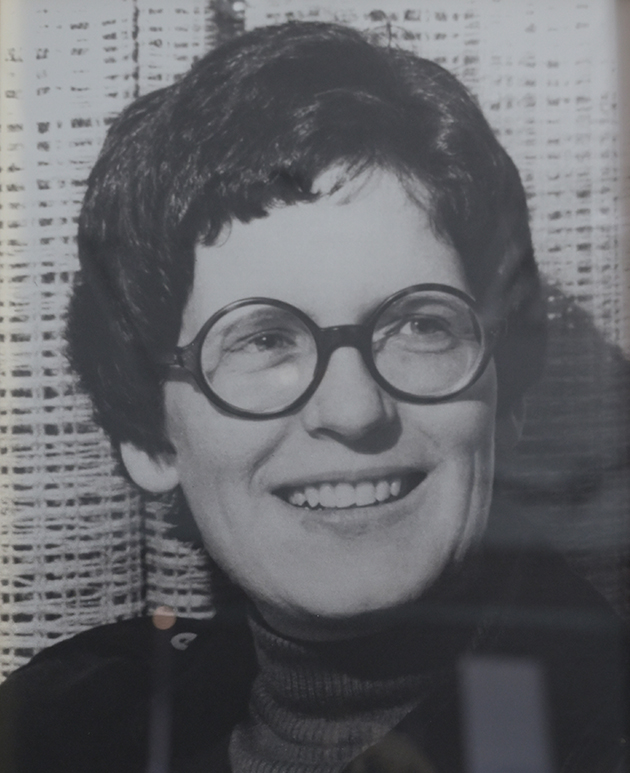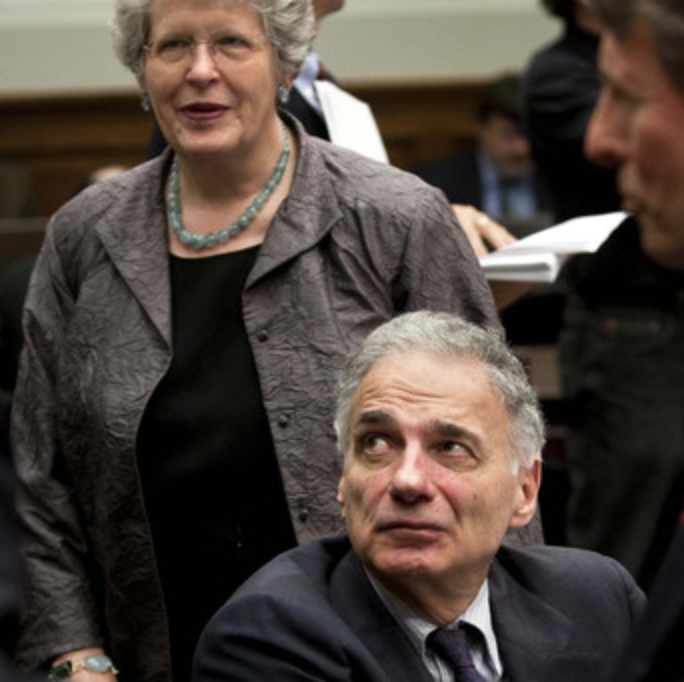‘The Auto Industry Went Berserk’: Five Questions with Joan Claybrook, Former Head of NHTSA
12:01 AM EDT on October 16, 2020

Joan Claybrook’s official portrait for the National Highway Traffic Safety Administration. Source: NHTSA.
Joan Claybrook was the first woman administrator of the National Highway Traffic Safety Administration, appointed by President Jimmy Carter, and was one of the most influential lobbyists for vehicle safety regulations in American history. At 83, she remains a passionate advocate for pedestrian safety, and recently signed an open letter to the administration she used to direct, urging it to adopt a slate of life-saving vehicle reforms. We spoke with her about her incredible career and what she wishes the federal government would do to save lives on our roadways.
Streetsblog: Tell us a little about your journey to the head of NHTSA.
Joan Claybrook: When I graduated from college I went to work at the social security administration in Baltimore, 1959. I was lucky, because it was a time when women had real trouble getting professional jobs. After about six years of service there, I was offered a fellowship in Washington, D.C. and I went work for a congressman who was interested in road safety. There really was no such thing as regulating the auto industry at the time, and it was a huge problem. [Note: In 1966, the U.S. roadway fatality rate per 100 million vehicle miles traveled was more than five times what it is today.]
Around that time, Ralph Nader published Unsafe at Any Speed. He and I met in Washington, and I worked with him to get the first vehicle regulations passed in 1966. [Note: The regulation was the National Traffic and Motor Vehicle Safety Act, which required automakers to meet national vehicle safety standards for the first time in history.] It wasn't easy; General Motors actually hired someone to tail Ralph and got a prostitute to cuddle him at the Safeway cookie counter to make him look bad. Ralph figured out it was a set-up, and we eventually figured out it was GM. The legislation passed, and of course, Ralph became a national hero.

So a little later on, I got a job with a new federal administration called the National Highway Safety Bureau, which later became NHTSA. When Nixon was elected, I feared my time in civil service was over. That presumption came true; I was downgraded in about a month. In 1971, I left the Bureau and went to work with Ralph [as his head lobbyist pushing for safety in the auto industry] for a few years.
When Carter got elected in 1976, the rumor started going around that he wanted to hire a lot of women for his administration. I suppose that's part of why I was recommended to be the head of NHTSA. Of course, the auto industry went berserk; they called me the Dragon Lady! So when I became their regulator, they hated it. But I didn’t mind; I just wanted to make people safer.
Streetsblog: What's are some reforms that you achieved during your time at NHTSA that you're particularly proud of?
Claybrook: Even back when I was still working under [first NHTSA Administrator William] Haddon, making our very first regulation plan, one of the first items on our list was pedestrian safety. Haddon was very interested in that, particularly hood ornaments. A lot of the time, when talk about how regulating automakers costs them money; well, removing hood ornaments from their cars actually saves them money. We had all these terrible pictures of little children whose heads were just the right height to be hit by one of those things during a crash.
So when I became administrator in 1977, one of the first things I did was issue a proposal to ban hood ornaments. Well, the industry went nuts — particularly Mercedes and Jaguar, which had these huge ornaments that stuck off the end of the hood.
It didn't happen right away. After a while of pushing it, the general counsel of NHTSA, whom I very much admired, actually came to me and said, "Joan, you’re amazing and going to get a lot of good things done for this country, but this fight about hood ornaments could end your career. I think you should withdraw this proposal."
Well, that was just a stab in my heart, but I knew he was right. By then I was in the middle of a huge fight to get airbags installed in cars, and to get side-impact protection, and increase fuel economy — all these things that we knew were going to save thousands of lives, and that we were making headway on in our negotiations with automakers. So I said, fine, I’ll withdraw this for now. But I also sent an unofficial letter to a bunch of industry leaders and told them that if they don’t solve this problem with hood ornaments on their own, I’m going to reissue this ban.
So initially, they made them bendable. That was their give. The domestic industry eventually just removed them altogether, but Mercedes, to this day, still has that damn hood ornament on their cars. I actually ended up buying a Mercedes a few years ago, and I took it off and made it into a Christmas tree ornament.

We did get the New Car Assessment program going in 1979, and started doing the first standardized crash tests. We issued the first airbag rule — that was a big fight, too. In 1978, General Motors made a big show of using little piglets to test the "safety" of airbags on their cars, and of course they strapped those poor things right up against the dashboard where the airbags would come out with the maximum amount of force. So, of course, there was an attempt to get that voted down; thankfully, it didn't work.
The other thing I did manage do was on school bus safety. You know that retractable sign that comes out and says stop? That was one of my things. I'm proud of that one.
Streetsblog: Were there any big reforms you pushed for behind the scenes that you didn't end up winning?
Claybrook: Oh, absolutely. Back in 1978, I went to the head of our rule-making office and said, "Mike, I want you to issue a rule on pedestrian safety for cars." The bumper, the windshield wipers, the hood — the whole thing should be re-designed to be minimally harmful to pedestrians. And he said, "Joan, that’s crazy! We can’t do that." And I tell you, when you have your top staff person resisting you, particularly when the others in your office aren't getting behind you either, that’s really hard. I didn’t get the rule issued, but I did make the industry think about it. We're still pushing them.
Streetsblog: What were your biggest barriers to getting more robust safety protections passed during your time at NHTSA?
Claybrook: Well, of course, was that the auto industry is violently opposed to them! They had the resources to solve these problems — they still do — but they don't. NHTSA, on the other hand, has never been well-funded. During my time, we just didn’t have the money to have an all-out pedestrian safety program – there was no Manhattan Project for pedestrian safety, and there still isn't.
We also didn’t have much cooperation from the Federal Highway Administration. NHTSA can only regulate the car itself, but, of course, pedestrian safety has so much to do with the design of the road. The FHWA had their own crash-testing facility; we did not, because we couldn't afford it. We had to go to contractors. It really should have been a joint project between us.
Streetsblog: What do you think of the current NHTSA administration's efforts to save lives?
Claybrook: They’ve done nothing for the public. I think we have to wait until a new administration comes in, and hopefully a really savvy one that wants to make safety a priority — which, by the way, is legally NHTSA's job. I hope the next NHTSA administrator takes it more seriously. I just want people to be safer.
This interview has been edited for clarity and length.
Kea Wilson has more than a dozen years experience as a writer telling emotional, urgent and actionable stories that motivate average Americans to get involved in making their cities better places. She is also a novelist, cyclist, and affordable housing advocate. She previously worked at Strong Towns, and currently lives in St. Louis, MO. Kea can be reached at kea@streetsblog.org or on Twitter @streetsblogkea. Please reach out to her with tips and submissions.
Read More:
Stay in touch
Sign up for our free newsletter
More from Streetsblog USA
How Car-Centric Cities Make Carrying For Families Stressful — Particularly For Women
Women do a disproportionate share of the care-related travel their households rely on — and car-focused planning isn't making matters easier.
Wednesday’s Headlines Build Green
A new bill dubbed "Build Green" would replace many of the climate-friendly elements Sen. Joe Manchin insisted on stripping from the Inflation Reduction Act.
E-Bikes and Creating Financially Sustainable Bike Share Programs
The number of customers using bike share in the U.S. and Canada is now at an all-time high thanks to e-bikes.
Tuesday’s Headlines Pick the Low-Hanging Fruit
Greg Shill argues that if a transformative road redesign isn't possible, it's time to talk about second-best strategies.
How to Fight a Texas-Sized Freeway Battle
A new book explores how Texas advocates are fighting back against destructive highway expansions. But what happened to those projects since it was sent to the printer?




